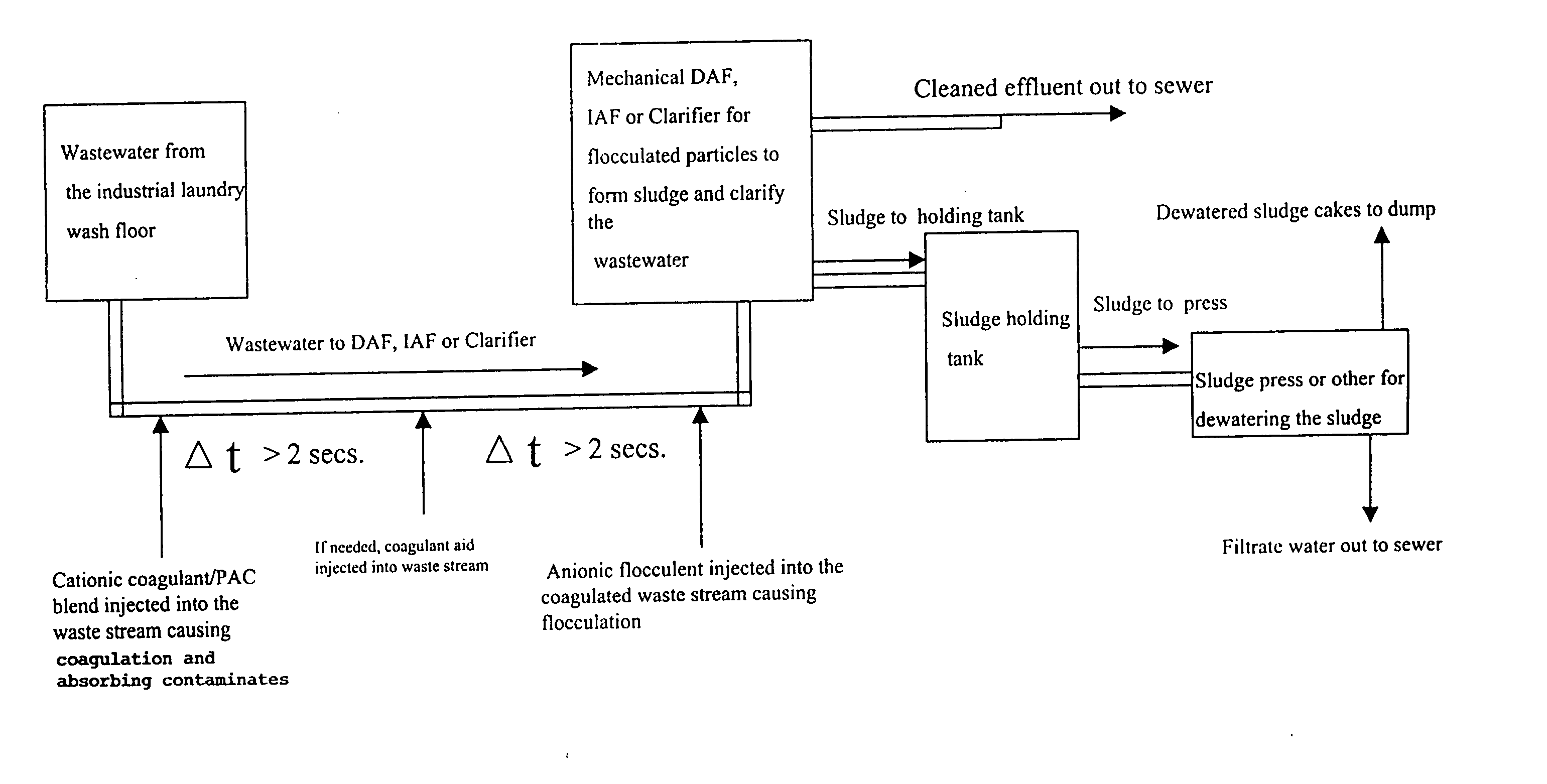Method of clarifying industrial wastewater for the reduction of organic waste content using cationic dispersion polymers combined with powdered activated carbon and anionic flocculent polymers
a technology of organic waste and cationic dispersion, applied in water/sewage multi-stage treatment, water treatment parameter control, separation process, etc., can solve the problems of insufficient reduction of organic waste to acceptable discharge standards, treatment methods, and more expensive disposal of these agents, so as to improve the ability of coagulant solution and improve the dewatering characteristics , the effect of cleaning the wastewater
- Summary
- Abstract
- Description
- Claims
- Application Information
AI Technical Summary
Benefits of technology
Problems solved by technology
Method used
Image
Examples
example one
[0034] Laundry plant #1 has a daily average water usage of 65,000 gallons per day with 50% of the input product being shop towels, mats, ink wipers and other heavy soils. The prior existing program being used for industrial pretreatment was a poly (diallydimethylammonium chloride) mixed with aluminum chlorhydrate solution with a dose rate of 200-500 ppm residence time for each chemical being 15-20 seconds at 125 gpm flow. This created coagulated particles that were then flocculated with a 0.2% polyacrylate flocculent at 6-8 ppm to produce particles able to be floated through mechanical means. The plate and frame press produced dewatered sludge cakes amounting to 60 cubic feet per day. Typical BOD results from effluent analysis ranged from 450 ppm to over 2000 mg / l.
[0035] The method of this invention was used to replace the prior existing program with a dose rate of 200-400 ppm of paculant [PAC and a poly (diallydimethylammonium chloride) mixed with aluminum chlorhydrate solution be...
example two
[0037] Laundry plant #2 with a daily average water usage of 80,000 gallons per day with 40% of the input product being shop towels, mats, ink wipers and other heavy soils. The prior existing program being used for industrial pretreatment was a poly (diallydimethylammonium chloride) mixed with aluminum chlorhydrate solution with a dose rate of 200-700 ppm residence time for each chemical was approximately six minutes for the first chemical and 10 seconds for the second chemical at 60 gpm flow. This created coagulated particles that were then flocculated with a “wetted” 0.2% polyacrylate flocculent at 6-8 ppm to produce particles able to be floated through mechanical means. Typical COD results from effluent analysis ranged from 800 ppm to over 2000 mg / l.
[0038] The method of this invention was used to replace the then existing program with a dose rate of 200-700 ppm of paculant using a mix time of approximately six minutes, and the application of the flocculent at 20-30 ppm using a mi...
PUM
| Property | Measurement | Unit |
|---|---|---|
| Time | aaaaa | aaaaa |
| Mesh size | aaaaa | aaaaa |
| Molecular weight | aaaaa | aaaaa |
Abstract
Description
Claims
Application Information
 Login to View More
Login to View More - R&D
- Intellectual Property
- Life Sciences
- Materials
- Tech Scout
- Unparalleled Data Quality
- Higher Quality Content
- 60% Fewer Hallucinations
Browse by: Latest US Patents, China's latest patents, Technical Efficacy Thesaurus, Application Domain, Technology Topic, Popular Technical Reports.
© 2025 PatSnap. All rights reserved.Legal|Privacy policy|Modern Slavery Act Transparency Statement|Sitemap|About US| Contact US: help@patsnap.com


